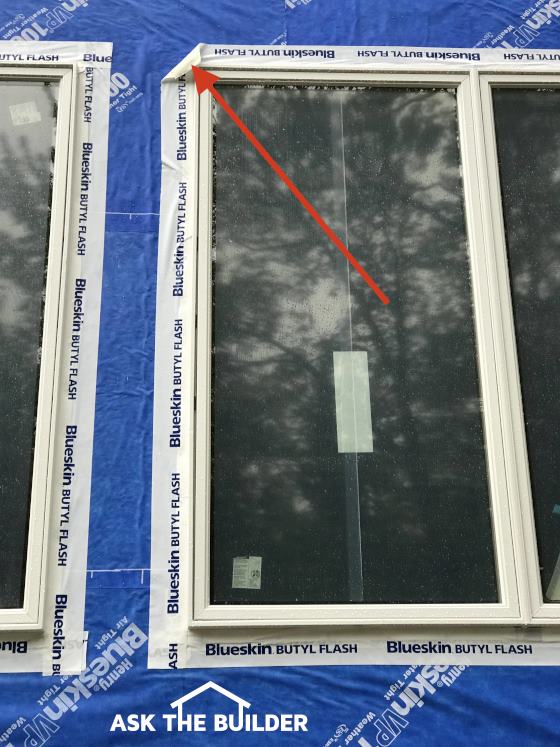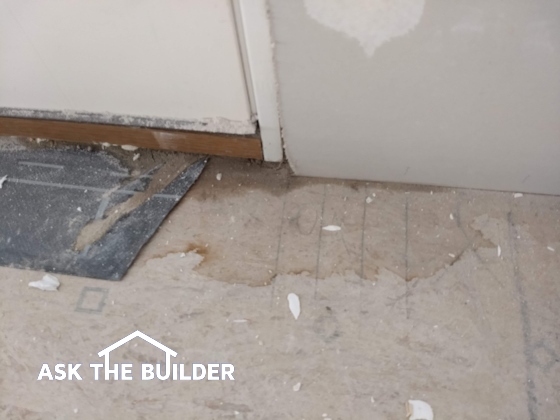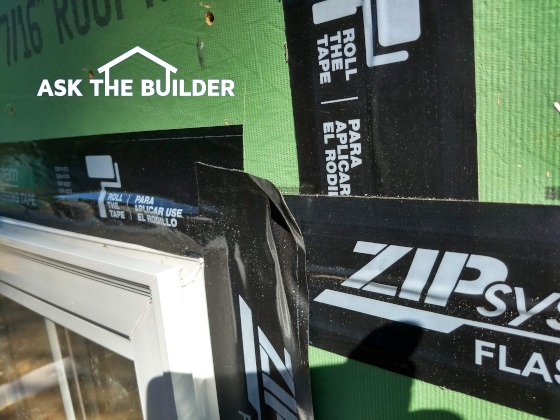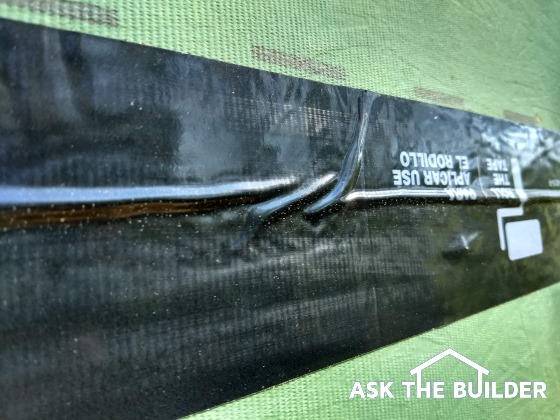Window Flashing Tape Leaking

Window Flashing Tape Leaking | The red arrow points to white flashing tape that failed to adhere and water leaked into this new home. This construction method flies in the face of decades of hard-earned knowledge that produces leak-free construction. (C) Copyright 2019 Tim Carter
"That remarkable simple and effective building detail is being sacrificed at the altar of Build-it-Faster."
Window Flashing Tape Leaking
I’ve been wanting to write this column for years. The topic has been a burr under my saddle, but I needed to base the column on proof, not speculation. That proof arrived last week in a desperate phone call from my son-in-law. He and my daughter are building a new home in Downeast Maine and water was leaking into their home across the top of windows just days before the drywall was to be installed. I predicted this might happen, and sure enough, it did. It’s important to realize I’m not the builder of this home but am their principal advisor.
A second event happened last week that’s directly connected to this column, but you might not immediately see the significance. An intense rainstorm caused the Pemigewasset River here near my house to flash flood. The raging water uncovered a hidden cofferdam at an abandoned mill next to the river. No one had any knowledge of this dam that was buried under 10, or more, feet of sand for possibly 200-plus years!

This cofferdam was uncovered in a flash flood on the Pemigewasset River in the late spring of 2019. It lay buried under as much as 15 feet of sand for possibly 200 years or more. Copyright 2019 Tim Carter
I’ve been aghast in the past few decades at a growing trend in the residential construction industry that is burying hard-earned tried and true construction methods that were developed and used by builders for centuries. I’m talking about the explosion of flashing tape that’s being installed around countless windows and doors in homes and room additions all across the USA, and possibly the world for that matter.
This disturbing trend reminds me of the powerful writing of J.R.R. Tolkien in his masterpiece The Fellowship of the Ring. Tolkien wrote, “And some things that should have not been forgotten were lost. History became legend. Legend became myth. And for two and a half thousand years, the ring passed out of all knowledge.”
I referred to this same quote in chapter one of my Roofing Ripoff expose’ book I wrote about why your asphalt shingle roof is falling apart before your eyes. Each day old craftsmen and craftswomen die and unfortunately take their knowledge to the grave. New young builders are left to try to come up with solutions to problems on their own. Engineers at companies are tasked with the same conundrum if they fail to pay attention to older engineers.

This is a water leak around a door in a brand new home that's still being built. The door was not flashed properly and water is leaking around and under the threshold. It's a ticking time bomb that could cost thousands of dollars to repair down the road. Copyright 2019 Tim Carter
The water leaking into my daughter and son-in-law’s new home is happening because the construction detail intended to prevent a leak depends on an adhesive on a piece of tape. Should the adhesive fail, water is sure to enter the home. It also depended upon expert installation methods from the person installing said tape. Another disturbing trend I’ve been observing is the disappearance of skilled laborers, but I digress. That’s a column for another day.
Mother Nature knows all about how to shed water to keep things dry. Apply your critical thinking skills to how feathers are layered on birds. Think about how fur is layered and coated on any number of animals that need to survive outdoors in bone-chilling cold and rainy days.

The corner of the tape in the center of the photo is already peeling. The causes are many. How long might it be before the other tape starts to peel away from the plastic-coated sheathing? Copyright 2019 Tim Carter
This same simple technology was used for centuries by builders to create dry and rot-free wood structures for years. Roof shingles and flashings are layered on roofs like feathers. Each shingle higher on a sloped roof overlaps the one below it. Gravity pulls the water down the roof to the ground.
Builders of old used the same method to keep walls dry. They overlapped pieces of asphalt-saturated paper in the same manner. When the paper passed over a door or window, the builders carefully installed a simple metal flashing that extended up the wood wall, was bent to pass over the top of the window or door trim, and then was bent a final time so about 1/4-inch of the metal lapped over the front of the window or door trim.
The best craftsmen made sure the metal was angled out slightly from the window or door trim to prevent capillary attraction from pulling the water up under the metal flashing.
Water dripping down behind the siding, or brick, or stone, or stucco would flow across the asphalt felt paper which overlapped the metal flashing on the wall. The water would then roll across the metal flashing and then flow out over the front of the window or door.

Look at the upward-angled pucker in the black tape at the center of the photo. The pucker is OPEN at the top and water can flow down into the tape and pass horizontally through the other horizontal pucker. The edges of the sheathing could start to rot and water can easily enter the wall cavity. Copyright 2019 Tim Carter
That remarkable simple and effective building detail is being sacrificed at the altar of Build-it-Faster. Just about every modern window or door has a built-in weatherproof nailing flange that can take the place of the older metal flashing. All that needs to happen is the top nailing flange needs to be carefully slid up behind the overlapping layers of weatherproof barrier above it. This weatherproof barrier is required to protect the wood framing of the house from water that gets behind siding, brick, stone, stucco, etc.
Many, not all, builders and laborers are using wide flashing tapes that overlap, not underlap, the materials above them. They hope that the adhesive doesn’t fail. If it does, water gets behind the tape and it’s game over.
I’ve maintained for years that it’s quite possible the adhesive on these tapes may not stand the test of time. Can the adhesive survive thousands of expansion and contraction cycles when the sun beats on a wall and transfers that heat to the tape?
My biggest beef is the tape that’s applied to the popular plastic-coated wall and roof sheathing. Your hopes for a dry structure are based entirely on whether or not the tape adhesive was installed perfectly and holds forever to that plastic coating.
I’m not a big fan of hope. You should only hope for things you can’t control. You can control how to make sure your new home or room addition never leaks. Just follow the footsteps of the master craftsmen/women of old.
Related Column: Window Flashing Tape
Column 1308
One Response to Window Flashing Tape Leaking